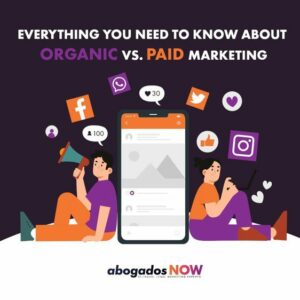The law of attraction states that we attract what we focus on in our lives. This may seem like some far-out, hippie-dippy theory, but it’s essentially the process behind organic marketing. Organic marketing attracts qualified traffic naturally (for free) rather than paying for ads or influencers.
The principle is simple. But do you know how to accomplish the goal?
This article is a crash course in organic vs. paid marketing techniques, and how to use them in conjunction with each other. We highly suggest bookmarking this page, because you’re definitely going to want to reference it for all of your upcoming campaigns.
But First, What is Organic Marketing?
The term “organic marketing” refers to the strategy which involves generating traffic to your firm’s site over time using blog posts, case studies, guest posts, and unpaid social media endeavors. Organic marketing leverages these and other channels to increase your digital footprint. While social media channels are a facet of organic marketing, your bread and butter will ultimately be found within the realm of your website content.
The goal is to increase brand awareness and to put your firm in front of a larger audience. The most effective way to do this while also building genuine connections is by sharing value-adding, educational content that will leave them wanting more. There are many ways to attract more prospects to your firm, but organic search is a critical one.
Organic marketing attracts more qualified visitors to your site, which should also result in a higher client conversion rate (if you’re targeting the right audience).
In order to measure the success of your organic marketing campaigns, you’ll have to analyze your content to see what is driving the most traffic to your site, what’s actually converting, how many leads a given campaign generates, and which channels are actually working for you.
How to Build an Organic Marketing Strategy
1. Analyze Your Traffic Sources
Take a deep dive into the current traffic patterns of your audience. Then, compare that to your ideal audience.
It’s crucial to know where your organic traffic comes from. Maybe it’s from your Youtube channel or your blog. Or maybe your newsletters are driving tons of traffic to your site. Once you understand where your current traffic comes from, consider how your ideal audience would find what they need in regard to legal services. Determine the organic content they’re looking for and invest your efforts in those channels.
2. Create the Right Content
You just completed step one. Now, you need to create the content to fill these channels.
Before you put pen to paper, make sure you’ve completed a thorough brainstorming session and figured out the kinds of assets you want to produce. For instance, if you want to focus on writing more blog posts, hone in on the keywords you want to use and check out what kind of posts your competitors are using to succeed. After you take all of these steps into consideration, you can start creating your own content.
3. Continue to Optimize Your Content
There is one factor that can make or break your content: optimization.
The ultimate goal is to have your content show up on the first page of the Google search or social media search you’re aiming for. The strategy for all of these will be pretty similar regardless of the medium. In order to optimize your content, incorporate the right keywords, have a user-friendly design, and leverage metadata to help search engines properly index your content.
4. Analyze and Improve
We hate to break it to you: your job is never finished.
In order to have an effective organic marketing strategy, you have to constantly assess your content and tweak what needs improvement. Enlist the help of SEO tools such as SEMrush to see how your content can be adjusted to help you rank higher. This type of software will also help you track your progress and see how close you are to hitting your KPIs.
It’s always important to remember that organic marketing is meant to naturally attract potential clients to your firm instead of investing in paid campaigns. Organic marketing not only attracts clients, but it also keeps people engaged in your content and positions you as a thought leader within your given practice area.
So Now, What is Paid Marketing?
We’ve already covered organic marketing and how its goal is more long-game. On the flip side, you have paid (or inorganic) marketing. This strategy utilizes paid methods to target, reach, engage, and ultimately convert a highly targeted audience much more quickly.
Inorganic marketing strategies include paid search and social media ads, sponsored content, display ads, video ads via Youtube, and more. Paid marketing enables you to micro-target smaller audiences – however, this “smaller audience” strategy may be more ideal for your firm. You might even reach people who might not have heard about your firm otherwise, and with more speed than with an organic strategy.
You can measure the success of your paid marketing campaigns by analyzing ROAS (return on ad spend). A few other keystone metrics to keep an eye on are impressions and (always) conversions. It’s easy to start a paid marketing campaign and take your hands off the wheel, which inevitably leads to bleeding money. Keep your eye on the metrics to ensure you’re not investing in the wrong avenues.
How to Combine Organic and Paid Marketing
Although these strategies are vastly different, they complement each other very well. In fact, they tend to work better when used together.
So, what would this look like? Say a firm posts and promotes their blogs on a regular basis. Maybe to amplify their content marketing strategy, they pair their blog posts (organic marketing) with a paid social media campaign (inorganic) to drive even more traffic. Marketers can even boost certain social posts with links to their site for some extra oomph.
Your knee-jerk reaction might be simply to throw money into a campaign and hope for massive returns. However, many marketing experts argue that firms who don’t leverage organic marketing to some degree are shooting themselves in the foot in the long run. In addition to missing out on huge SEO opportunities, firms are also skipping out on the chance to build genuine relationships with their existing and potential clients.
Organic and paid marketing techniques both serve different purposes; when used in tandem, their effects are exponentially magnified. By combining these strategies, we’ll help you grow your firm in no time.
Good Luck with Your Next Campaign!
Congrats on becoming an expert on organic vs paid marketing strategies!
We hope that with these tips and insights in mind, your next campaign will drive more qualified traffic to your firm’s site and land you more clients.
Full steam ahead!





